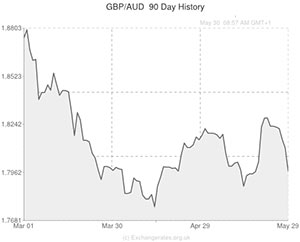
Overnight the GBP to AUD pairing put in a mixed performance as the Pound was buoyed by encouraging UK confidence and house price data.
The UK’s GfK consumer confidence measure jumped to a nine-month high of 0 in May, up from -3 the previous month and exceeding expectations for a reading of -2.
However, while the report showed that the UK populace is getting more confident about the economic situation at large, their opinion on their own personal finances was less sanguine.
The Pound was also boosted by the Hometrack housing survey. The data revealed that UK house prices increased by 0.5 per cent in May, month-on-month, only slightly less than the 0.6 per cent monthly increase recorded in April.
The Bank of England has previously expressed concerns over the strength of the UK housing market and this report could add to the case for the central bank increasing interest rates before the spring of next year.
On an annual basis house prices were up 6.1 per cent.
However, Sterling gains were a little restricted as an official from the British Chambers of Commerce expressed frustration over the mixed messages coming from the BoE regarding the increasing of interest rates.
David Kern stated; ‘The Monetary Policy Committee’s efforts […] are being hampered by apparent inconsistencies between Governor Carney’s reassuring comments and the MPC’s minutes. The strong rise in Sterling over the past year, which makes our exports more expensive, is an important reason for not raising rates prematurely.’
The Pound was also prevented from posting a notable advance against the ‘Aussie’ by upbeat Australian data.
Australia’s private sector credit report showed that the 0.4 per cent month-on-month increase recorded in March was followed by a 0.5 per cent increase in April.
On the year private sector credit was up 4.6 per cent last month, beating estimates for a 4.5 per cent annual increase.
Personal credit held steady, but housing and business credit increased by 0.6 per cent and 0.3 per cent respectively.
Personal loans were up 0.5 per cent on the year and business loans increased by 2.7 per cent on an annual basis.
After the report was published the Australian Dollar held above 93 cents against the US Dollar and advanced on the Euro, defying a drop in the price of iron ore – one of Australia’s major exports.
The Pound to Australian Dollar exchange rate was trading in a narrow range and is unlikely to experience much additional movement before the weekend.
Australian Dollar (AUD) Exchange Rates
[table width=”100%” colwidth=”50|50|50|50|50″ colalign=”left|left|left|left|left”]
Currency, ,Currency,Rate ,
Australian Dollar, ,US Dollar, 0.9306,
,US Dollar, 0.9306,
Australian Dollar, ,Euro, 0.6844,
,Euro, 0.6844,
Australian Dollar, ,Pound, 0.5561,
,Pound, 0.5561,
Australian Dollar, ,New Zealand Dollar, 1.0978,
,New Zealand Dollar, 1.0978,
US Dollar, ,Australian Dollar, 1.0734,
,Australian Dollar, 1.0734,
Euro, ,Australian Dollar, 1.4612,
,Australian Dollar, 1.4612,
Pound Sterling, ,Australian Dollar, 1.7982,
,Australian Dollar, 1.7982,
New Zealand Dollar, ,Australian Dollar, 0.9120,
,Australian Dollar, 0.9120,
[/table]

Comments are closed.